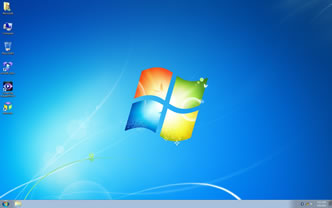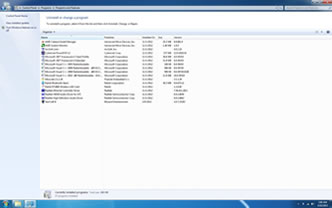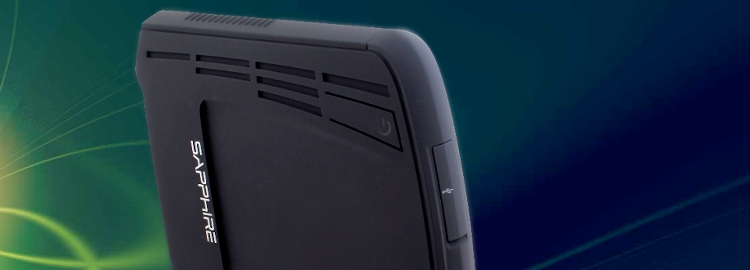While full-sized desktop computers are still around, tablets and smartphones have proven that technology has come far enough to essentially cram a fully capable computer into a space that is suitable for your pants pocket, a purse, or a small backpack. This idea of shrinking hardware hasn't been overlooked by manufacturers as several now feature space-saving designs based on mobile hardware.
Such is the case with Sapphire's new Edge VS8 mini-PC powered by AMD's A8 APU. The system is hardly any larger than an external optical drive, measuring 19.7 x 18.2 x 3.1 cms. Net weight for the mini PC is just 660g.
The Edge VS8 ships with AMD's quad-core A8-4555M clocked at 1.6GHz, 4GB of DDR3 memory, AMD Radeon HD 7600G graphics and a 500GB 2.5-inch SATA hard drive. The Edge VS8 comes with built-in support for Bluetooth 3.0 as well as 802.11 b/g/n wireless and a bevy of rear I/O connections. Our review unit had Windows 7 installed but Sapphire also configures these systems with Windows 8 if you so choose.
Included in the retail package is the computer itself, an HDMI cable, an HDMI to DVI adapter, a power cord and 65W power adapter, chassis stand, driver disc with quick installation guide, an optical SPDIF cable and a VESA mount. Sapphire also included a Cross pen and carrying case as an extra incentive.
The system doesn't ship with any extra amenities like speakers, a keyboard, mouse or a monitor so note that you'll have to include those when budgeting for the system or simply reuse gear you may already own. We were able to find the VS8 as equipped here today for just over $500 on Amazon at the time of this review.
Sapphire Edge VS8 - $505
- AMD A8 1.6GHz Quad Core APU
- AMD Radeon HD 7600G graphics
- 4GB DDR3 So-DIMM
- 500 GB SATA 2.5-inch Hard Drive
- 1 x Mini Display Port, 1 x HDMI, Gigabit Lan, 4 x USB 2.0, 2 x USB 3.0 Port, SD Card Reader
- 1 x Audio-in, 1 x Line-out, 1 x Optical SPDIF
- 802.11b/g/n, Bluetooth 3.0
- 11.5 x 4.25 x 10 inches, 1.3 pounds
Aesthetically, the VS8 looks more like a cable modem or router than a full-fledged computer. The chassis is coated in a smooth black rubber material with a set of activity LEDs, a microSD card slot and a pair of USB 3.0 ports gracing the front bezel - the latter of which are hidden behind a removable access panel that you'll need to pry open from the bottom.
The system's power button is located on the left side of the unit and could be hard to miss as it blends in with the swooping design of the cooling vents near the top. The Sapphire nameplate is positioned prominently on the left panel in a vertical orientation.
On the reverse we find, from top to bottom: a pin-hole reset button, Mini DisplayPort connector, HDMI port, four USB 2.0 ports, an Ethernet jack, DC-in connector, audio jack, optical SPDIF and a locking slot. There are three Philips screws on the back panel which we presume would grant access to the interior but aside from swapping the hard drive for a SSD or replacing the memory, there's not much you can do in the way of upgrades.


The right side of the PC is a mirror image of the left save for the power button. You'll also find the system's identification stickers as well as the Windows product key on a separate sticker. The top and the bottom both feature ventilation slots with the difference being the mounting screw hole on the bottom.
Software and Performance
The VS8 arrived with an extremely clean install of Windows 7 Ultimate 32-bit. Note that the 32-bit version of Windows will limit the effective amount of RAM you could potentially add to the system as anything over 4GB will go unused unless you are running a 64-bit OS.
That aside, there were only a couple of programs that I would consider getting rid of: Moovida Media Player and Cyberlink PowerDVD 12. The latter is a strange addition as the VS8 doesn't include an optical drive, but I digress. The lack of software means there isn't any signature software to cover like we typically find with other desktops or notebooks from big brand manufacturers. Either way, props to Sapphire for such a tidy OS install.
Benchmark Results
| Synthetic Tests | Sapphire Edge VS8 | Aspire S7 | Yoga 13 | Aspire S5 |
| 3DMark 06 | ||||
| 3DMark Score | 4910 3DMarks | 5000 3DMarks | 4393 3DMarks | 5263 3DMarks |
| PCMark Vantage | ||||
| PCMark Suite | 4584 PCMarks | N/A | N/A | 13643 PCMarks |
| Application Tests | Sapphire Edge VS8 | Aspire S7 | Yoga 13 | Aspire S5 |
| iTunes Encoding Test | 2 min 30 sec | 1 min 20 sec | 1 min 25 sec | 1 min 15 sec |
| File Transfer Test | ||||
| Small files | 1 min 30 sec | 16 sec | 24 sec | 10 sec |
| Large file | 1 min 1 sec | 17 sec | 22 sec | 10 sec |
The iTunes encoding tests consist of converting 14 MP3s (119MB) to 128Kbps ACC files and measuring the operation's duration in seconds. For file transfers, we measure how long it takes to copy two sets of files from one location to another on the same hard drive. On the small files test we transfer 557 MP3s, totaling 2.56GB. For the large file, these same MP3s were zipped into a single file measuring 2.52GB.
| Gaming Performance | Sapphire Edge VS8 | Aspire S7 | Yoga 13 | Aspire S5 |
| Far Cry 2 | ||||
| 1024x768, Medium Quality | 30 fps | 26 fps | 23.5 fps | 35.2 fps |
| 1680 x 1050 or native res, High Quality | 19.4 fps | 11 fps | 15.3 fps | 21.9 fps |
| StarCraft 2 | ||||
| 1024x768, Medium Quality | 16.7 fps | 19 fps | 16.9 fps | 21.8 fps |
| 1680 x 1050 or native res, High Quality | 12.7 fps | 11 fps | 10.8 fps | 15.2 fps |
|
|
|
|
Usage Impressions, Conclusion
I found it of note that Sapphire sent us the VS8 running Windows 7. Although they also offer the system with Microsoft's most recent OS, I'd suspect most people are still more comfortable with Windows 7 on the desktop.
Connectivity options on the VS8 were abundant, especially considering the system's small size. Of notable interest were the two USB 3.0 ports, Mini DisplayPort and the HDMI connector. Built-in Wi-Fi and Bluetooth are also a plus as you won't have to run an Ethernet cable to the system to get online.


A clean OEM Windows install. Somewhat of a rarity these days.
AMD's quad-core A8 APU was able to muscle through most daily tasks like web browsing without much fuss although our informal YouTube 4K resolution video test pushed the CPU to 99 percent and resulted in a jittery, unwatchable experience.
What's more, the AMD Radeon HD 7600G graphics are capable of playing some older titles on moderate settings but don't expect miracles, especially when you crank up the resolution. Far Cry 2 and StarCraft 2 are far from last-generation titles, and those were mostly unplayable at decent settings on the Edge VS8. In fact, the performance resembled that of Intel's HD 4000 built-in graphics used on most laptops these days.
The good news here is that none of the internal hardware requires a ton of power which means less heat, less noise and ultimately, a lower power bill.
If I could change one thing about this system, I'd swap the 500GB 2.5-inch SATA hard drive for a speedier solid state drive. I have a feeling that would really wake up the system and put the bottleneck firmly on the CPU/GPU instead of on the storage system. I also found it a bit odd that Sapphire shipped the driver pack on a CD rather than on a flash drive as the system doesn't include an optical drive.

A system like this will most likely appeal to someone with limited desk real estate, someone that wants a secondary computer for basic tasks like web surfing, e-mail and keeping up with friends and family on social networks or someone that wants a true computer to use as a HTPC.
Priced at just over $500 at the time of this review, one could make a solid argument that the same amount of money could be invested into a capable notebook computer that takes up even less space and includes a display, keyboard, etc. That wouldn't really be an option, however, if you aren't interested in a notebook. But as a small form factor computer, the Sapphire VS8 excels in a number of categories.
score
Pros: Small and quiet, plenty of ports, solid GPU performance for the price. No bloatware.
Cons: Slow hard drive. $500 not as cheap after factoring in monitor and peripherals.

